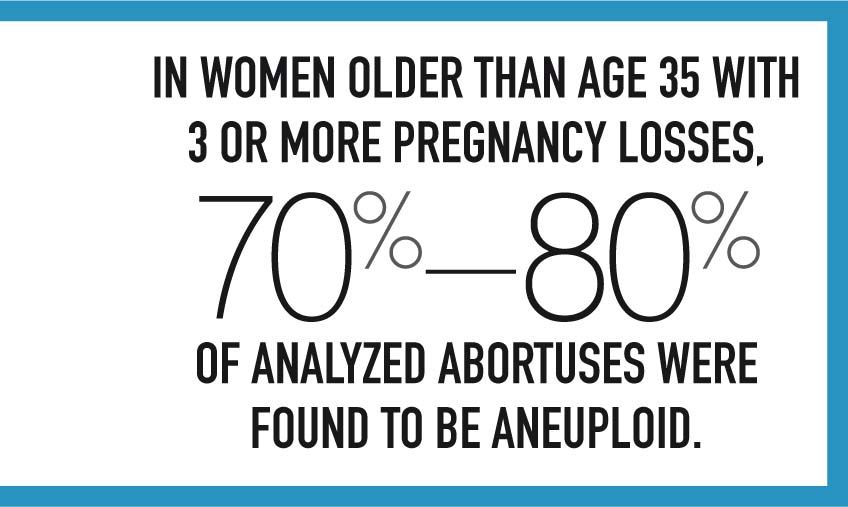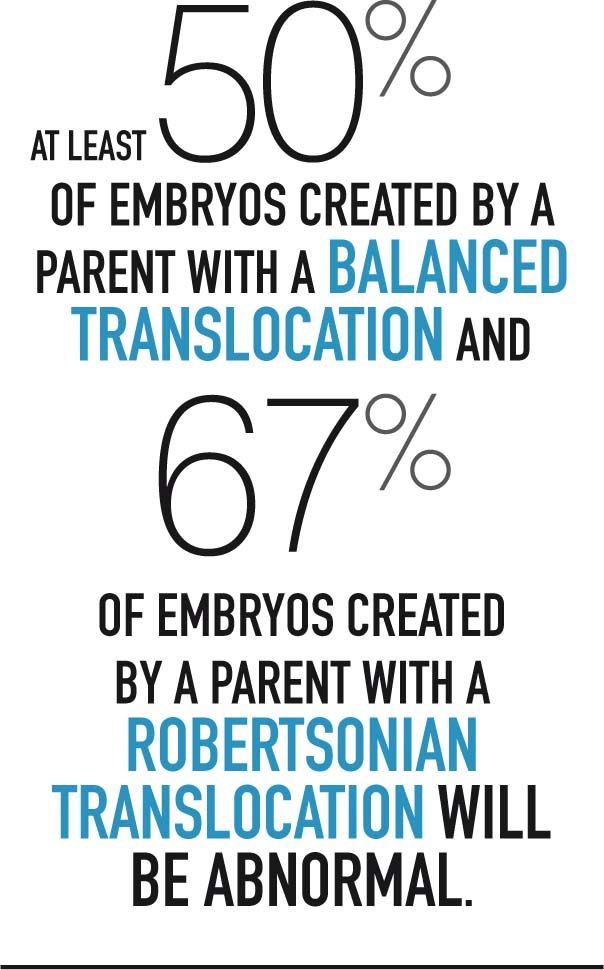The role of IVF with PGS in recurrent miscarriage
Consequences of reproductive aging include infertility, an increased likelihood of isolated spontaneous abortion (SAB), and likely an increased likelihood of recurrent pregnancy loss (RPL).

Dr Plosker is Professor and Division Director, IVF and Reproductive Endocrinology, University of South Florida, Tampa. He has no conflicts of interest to report in respect to the content of this article.
Consequences of reproductive aging include infertility, an increased likelihood of isolated spontaneous abortion (SAB), and likely an increased likelihood of recurrent pregnancy loss (RPL).1-3 One percent to 5% of women experience RPL, which is defined as 2 or 3 consecutive clinical pregnancy losses.4 As women age, an increasing percentage of embryos are aneuploid,5,6 contributing to the increased prevalence of infertility and the increased prevalence of SAB and viable trisomies with maternal aging.
In women older than age 35 with 3 or more pregnancy losses, 70%–80% of analyzed abortuses were found to be aneuploid.3,6 Whereas aneuploidy embryos rarely implant, and those that do often end in spontaneous abortion, euploid embryos have implantation rates in the 80% range, with a 65% live birth rate.7
Preimplantation genetic screening (PGS) of embryos achieved through IVF is an intervention that can identify euploid embryos. Indeed, PGS has been used to treat RPL.8 In the absence of randomized controlled trials (RCTs) comparing IVF with PGS to expectant management in women with RPL, a thoughtful, measured approach to the application of a complex, expensive treatment is warranted.
RPL due to structural chromosome abnormalities is usually the result of aneuploidy caused by oocyte nondisjunction during meiosis I, which is an age-dependent process.5 However, in 2%–5% of couples suffering from RPL, one of the parents is found to harbor a balanced reciprocal translocation, or a Robertsonian translocation.4 According to probability theory, at least 50% of embryos created by a parent with a balanced translocation and 67% of embryos created by a parent with a Robertsonian translocation will be abnormal. In practice, the prevalence of aneuploidy or unbalanced embryos is often higher, since some reciprocal translocations are predisposed to abnormal segregation patterns, and all gamete unions are subject to a high likelihood of aneuploidy due to nondisjunction.5
Related: Diagnosis and management of recurrent pregnancy loss
When evaluating the utility of PGS in the treatment of idiopathic RPL, or in RPL associated with chromosome structural rearrangements, particularly in women of advanced reproductive age, consider:
What is the likelihood of spontaneously conceiving a live birth with a history of RPL? Brigham et al. found that 75% of women with RPL (mean 3.0 prior losses) conceived an intrauterine pregnancy, and 75% of intrauterine conceptions survived beyond 24 weeks’ gestation. This suggests a live birth rate of 56% among their cohort of 302 women. Using logistic regression, they predicted a live birth from 80% of intrauterine conceptions at age 30, 73% at age 35, and 64% at age 40.9
What is the likelihood of infertility in women of advanced reproductive age who have RPL? The cumulative 12-month pregnancy rate in women with no prior history of infertility attempting to conceive is 87%-88% in women aged 30-33, 76% in women aged 36-37, and 54% by age 40–41.1
These rates are likely to be lower in women with RPL. In women with RPL, Brigham et al. found that 25% of their cohort of women never conceived after entering the study, although they did not discern if this was due to infertility or to cessation of trying to conceive.9 This suggests that RPL due to aneuploidy may be a harbinger of infertility in older women.
How successful is IVF in women of advanced reproductive age? In 2014, national IVF live birth rates per initiated cycle were 49% in women aged younger than 35, 38% in women aged 35–37, 24% in women aged 38–40, and 12% in women aged 41–42 (SARTCORSonline.com).
NEXT: Does PGS increase the risk of another spontaneous abortion?
What is the likelihood that an IVF cycle with PGS will:
a) yield embryos that can be
tested, and
b) identify euploid embryos?
PGS requires removal of several cells from the trophectoderm of a day-5 or day-6 post-egg-retrieval blastocyst embryo. A reasonable estimate is that approximately 30%–50% of day-3 embryos will progress to blastocyst,10,11 slightly fewer than 50% of biopsied blastocysts in a cohort of women with idiopathic RPL will prove to be euploid,8 and approximately 25% of biopsied embryos in a cohort with a structural chromosome rearrangement will be euploid.12
More: Are you prepared for expanded carrier screening?
These observations suggest that, at best, 25% of all embryos produced will be euploid in idiopathic RPL and 10%–15% will be euploid when a parent harbors a chromosomal structural abnormality. In an intent-to-treat analysis of 112 patients with RPL who chose IVF with PGS, with a mean age of 37.1 years, PGS could not be performed in 38/168 (23%) retrievals due to poor embryo yield or quality. Of the 130 retrievals in which PGS was performed, 27 (21% of cycles in which PGS was completed, 16% of all initiated cycles) did not yield a euploid embryo to transfer.

At least one euploid embryo was identified in 61% of initiated IVF cycles, and in 79% of cycles in which PGS was performed.13
Does PGS increase the likelihood of having a live birth? Does PGS reduce the risk of another spontaneous abortion?
No prospective randomized or longitudinal studies answer this question. Data from retrospective and case series are discrepant. In the above-noted retrospective, intent-to-treat, cohort analysis, Murugappan et al. compared 112 patients with RPL who desired IVF with PGS to 188 patients with RPL who opted for expectant management.

Comparing a single IVF cycle to 6 months of expectant management, they found no differences in rates of live birth (32% vs 34%) or miscarriage (20% vs 24%), between the IVF/PGS group and the expectant management group. When the analysis was limited to the 61% of IVF/PGS cycles in which a euploid embryo was available to transfer, the live birth rate was 57%, which was significantly better than the 34% live birth rate after 6 months of expectant management.
The miscarriage rate in the group that had a euploid embryo transfer was 14%, not statistically significantly lower than in the expectant management group (24%). Specifically in women older than 35 who had RPL, those who were able to have a euploid embryo transfer had a 59% live birth rate, compared to a 28% live birth rate in the expectant management group. The miscarriage rate, 14% versus 24%, again did not attain statistical significance.13
In contrast, an earlier case series suggested that IVF/PGS lowered the miscarriage rate in women with RPL from an estimated 33.5% to 6.9%.8
NEXT: Is there a risk to PGS?
Is there a risk to PGS?
Prior to the advent of trophectoderm biopsy and the availability of comprehensive chromosome screening of all 23 chromosome pairs, RCTs of PGS in women at risk of aneuploidy due to advanced maternal age consistently showed a lower pregnancy rate after embryo biopsy.14
More recently, a paired randomized clinical trial in which 2 embryos, one that underwent biopsy for PGS and one that did not, were transferred demonstrated that trophectoderm biopsy did not decrease implantation rate.15 This suggests that PGS does not have any detrimental effect on embryo competence, pending further validation studies.
Next: It's time for preimplantation genetic diagnosis
What is the cost of achieving a pregnancy using IVF with PGS compared with expectant management? From my personal observation, a single IVF cycle with PGS is likely to approach or exceed $20,000. Using a decision analytic model comparing costs and clinical outcomes, Murugappan et al. estimated a cost of $418 to achieve a live birth with expectant management, compared with $45,300 to achieve a live birth with IVF and PGS.16
Summary
In women of advanced reproductive age with RPL:
• There is no evidence that IVF with PGS improves overall live birth rates compared with expectant management, because a significant number of IVF cycles either do not undergo PGS or fail to identify euploid embryos. However, when euploid embryos are identified in women older than age 35, the live birth rate is improved.
• IVF with PGS probably improves miscarriage rates compared with expectant management, although current published data is inconclusive.
• The likelihood of achieving a live birth, either with expectant management or with IVF/PGS, is reasonable.

• The limited rates of success with IVF in women of advanced reproductive age, its cost, and the large proportion of IVF cycles that will not provide a euploid embryo to transfer must be factored into the decision about whether to pursue IVF with PGS for RPL.
• Efforts to identify women of advanced reproductive age with RPL and infertility are appropriate when considering who might best be served by expectant management and who by IVF with PGS. Ovarian reserve assessment with ultrasound antral follicle counts, anti-Mullerian hormone, and day-3 FSH may help to predict best candidates for IVF with PGS.
• The decision to consider IVF with PGS, rather than expectant management, for women of advanced reproductive age is nuanced and requires consideration of multiple factor.
References
1. Steiner AZ, Jukic AM. Impact of female age and nulligravidity on fecundity in an older reproductive age cohort. Fertil Steril. 2016;105:1584-8 e1.
2. Nybo Andersen AM, Wohlfahrt J, Christens P, Olsen J, Melbye M. Maternal age and fetal loss: population based register linkage study. BMJ. 2000;320:1708-12.
3. Marquard K, Westphal LM, Milki AA, Lathi RB. Etiology of recurrent pregnancy loss in women over the age of 35 years. Fertil Steril. 2010;94:1473-7.
4. Practice Committee of the American Society for Reproductive M. Evaluation and treatment of recurrent pregnancy loss: a committee opinion. Fertil Steril. 2012;98:1103-11.
5. Lalioti MD. Can preimplantation genetic diagnosis overcome recurrent pregnancy failure? Curr Opin Obstet Gynecol. 2008;20:199-204.
6. Grande M, Borrell A, Garcia-Posada R, et al. The effect of maternal age on chromosomal anomaly rate and spectrum in recurrent miscarriage. Hum Reprod. 2012;27:3109-17.
7. Scott RT, Jr., Upham KM, Forman EJ, et al. Blastocyst biopsy with comprehensive chromosome screening and fresh embryo transfer significantly increases in vitro fertilization implantation and delivery rates: a randomized controlled trial. Fertil Steril. 2013;100:697-703.
8. Hodes-Wertz B, Grifo J, Ghadir S, et al. Idiopathic recurrent miscarriage is caused mostly by aneuploid embryos. Fertil Steril. 2012;98:675-80.
9. Brigham SA, Conlon C, Farquharson RG. A longitudinal study of pregnancy outcome following idiopathic recurrent miscarriage. Hum Reprod. 1999;14:2868-71.
10. Dessolle L, Freour T, Barriere P, et al. A cycle-based model to predict blastocyst transfer cancellation. Hum Reprod. 2010;25:598-604.
11. Thomas MR, Sparks AE, Ryan GL, Van Voorhis BJ. Clinical predictors of human blastocyst formation and pregnancy after extended embryo culture and transfer. Fertil Steril. 2010;94:543-8.
12. Cameron E, Klavanian J, Gordon TT, Hughes MR. Comprehensive Review of Chromosome Rearrangement Cases Analyzed by Preimplantation Genetic Screening. Fertil Steril. 2016;106:e59.
13. Murugappan G, Shahine LK, Perfetto CO, Hickok LR, Lathi RB. Intent to treat analysis of in vitro fertilization and preimplantation genetic screening versus expectant management in patients with recurrent pregnancy loss. Hum Reprod. 2016;31:1668-74.
14. Mastenbroek S, Twisk M, van der Veen F, Repping S. Preimplantation genetic screening: a systematic review and meta-analysis of RCTs. Hum Reprod Update. 2011;17:454-66.
15. Scott RT, Upham KM, Forman EJ, Zhao T, Treff NR. Cleavage-stage biopsy significantly impairs human embryonic implantation potential while blastocyst biopsy does not: a randomized and paired clinical trial. Fertil Steril. 2013;100:624-30
16. Murugappan G, Ohno MS, Lathi RB. Cost-effectiveness analysis of preimplantation genetic screening and in vitro fertilization versus expectant management in patients with unexplained recurrent pregnancy loss. Fertil Steril. 2015;103:1215-20.
